Ben Shelton, 21, has the fastest serve in HISTORY and will be the face of American tennis for a decade… but he dreamed of a VERY different career
At 12, Ben Shelton was like millions of other American teenagers: his only dream was to be an NFL quarterback. He also loved baseball. Tennis? Just the occasional game, a little mixed doubles with his parents and sister. He had never left the shores of the United States.
Just nine years later, he’s the 14th-best tennis player in the world and one of his country’s top hopes at next week’s U.S. Open. And that ball-arm honed since childhood to throw fastballs and pass to wide receivers has been rebuilt to deliver the world’s deadliest serve.
In a sport where six years is relatively late for aspiring professionals to get started, Shelton’s story is not only an exception, it is unprecedented.
‘I played a lot of other sports as a kid,’ the 21-year-old tells Mail Sport. ‘I played basketball, football, baseball, soccer, I did it all. The sport I really fell in love with was football. I played until I was 12 and then I started taking tennis a bit more seriously – probably because my sister had a bit of success, she’s a year and a half older and I wanted to follow in her footsteps.’
So the NFL was the plan? ‘100%. College football first. When you’re a little kid and you do that stuff in school, what do you want to be when you grow up? Every year I wrote pro football player, pro football player, always.
At the age of 21, Ben Shelton has already become one of America’s top tennis talents
“That was the path I dreamed of and hoped to walk, but I’m happy with where I ended up!”
What makes his unconventional journey to the top of his – ultimately – chosen sport all the more surprising is that his father Bryan Shelton was a fine player in his own right, reaching the fourth round of Wimbledon in 1994 and finishing at No. 55 in the world.
A casual observer might look at the Sheltons and recognize the same old story: tennis dad coaches tennis kid from the cradle, catches the apple and slides it just past the tree.
“That was absolutely not the case,” Shelton says. “I think my dad was okay with me not playing tennis because he knows how hard the path is. He knows tennis is one of the most expensive sports to do and it should be paid for out of his own pocket!”
Shelton learned the game late from his father, while playing for the University of Florida team where Bryan was head coach. Last June, Bryan quit his job to travel with Ben full-time.
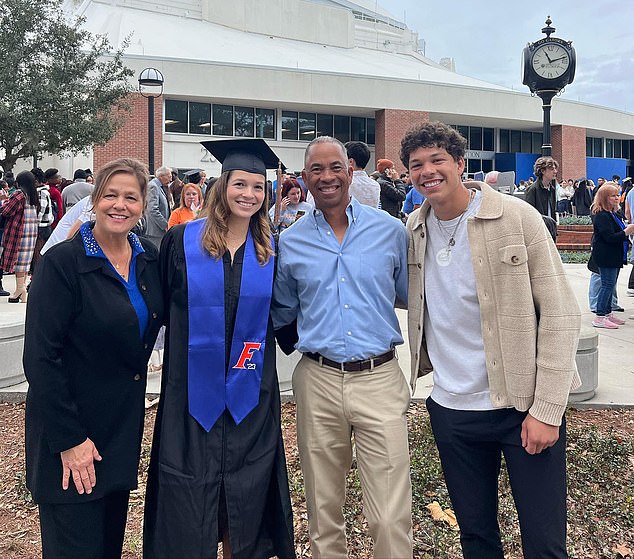
Shelton (right) poses with his family at his sister’s graduation ceremony last December
Scott Perelman was Bryan’s assistant at the University of Florida and helped coach Ben when his interest in tennis was first piqued.
‘I first met Benny when he was nine years old,’ he tells Mail Sport. ‘At that point he didn’t want anything to do with tennis. He would have told you at that age, my dad was a tennis player; I’m not going down that path at all.’
“His father just wanted Benny to be happy and involved in a sport that he was passionate about. And at a young age, that passion wasn’t tennis.”
At 6’3”, Shelton is tall, but not by the standards of the biggest servers in history. Still, he fired two 150 mph rockets in the same match at last year’s US Open. If you filter out the obvious speed gun errors or overshoots, Shelton’s serve is the fastest of all time.
How does he do it? The key is those early years when he did everything except tennis.
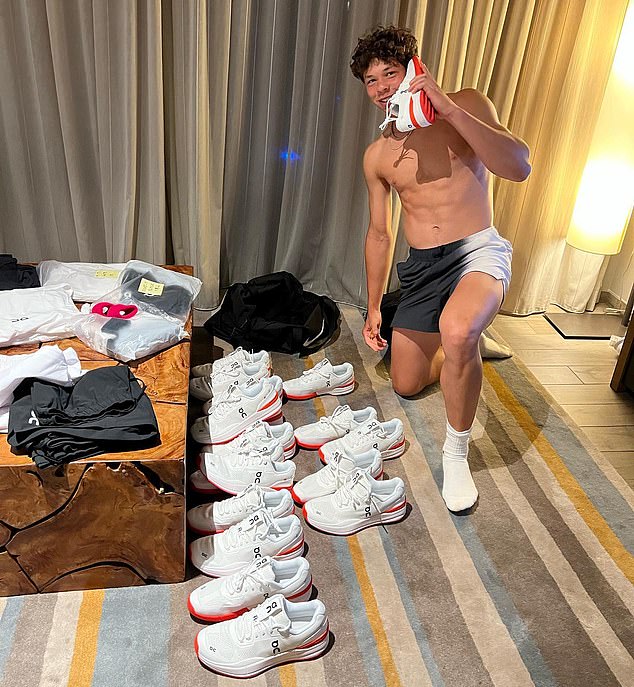
Shelton is a big hope for the US at next week’s US Open, and will first face Dominic Thiem
“Serve speed is more about technique than just power,” Shelton says. “Big, strong guys sometimes serve huge, sometimes not.
“I learned a great throwing motion at a young age playing soccer and baseball. It always looked like I was throwing a ball and I think I carried that over to my serve motion.”
In addition to having the fastest serve in the world, Shelton also has the most variety. He can apply a tremendous amount of “kick” – the spin applied by brushing the back of the ball – causing the serve to rise off the court and bounce out of reach.
Perelman attributes that aspect of Shelton’s serve to his years as a baseball pitcher learning to balance fastballs and curveballs.
“What we’ve talked about with Ben since he was in college is to be a pitcher with your serve,” he says. “Not just a fastball — vary the speed, vary the spin, vary the power, that’s where ultimate effectiveness comes in. And that’s what sets him apart.”
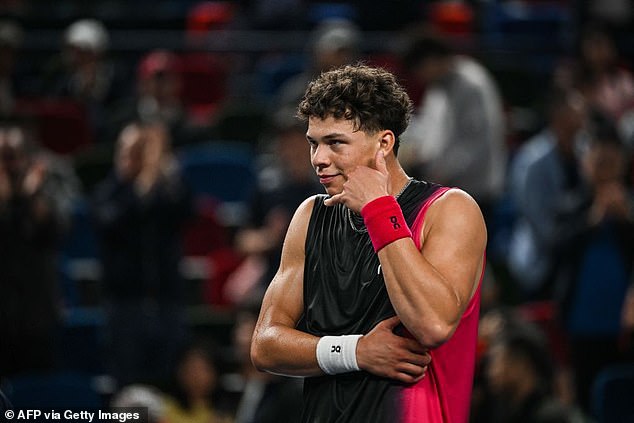
The tennis star embarrassed Novak Djokovic last year with his ‘recorded’ phone celebration
But Shelton’s game is far from just a serve. He’s an explosive athlete with a rocket forehand, a steady backhand and a well-rounded all-court game. From a pure tennis perspective, he’s a bit like Nick Kyrgios. Kyrgios’ talent, as Perelman puts it, “a strong will to excel and an extraordinary work ethic” – that’s a deadly combination.
And there’s so much more to come, as this is only his second year on tour and his ninth year playing the sport.
Perelman has no doubts about Shelton’s potential, saying, “I remember telling Bryan that coaching Ben in a competition situation is like riding the horse Secretariat (the legendary three-time U.S. Thoroughbred champion).
“This is a rare air in tennis – guys who are the total package like Ben. He has all the intangibles to be the best player in the world.”
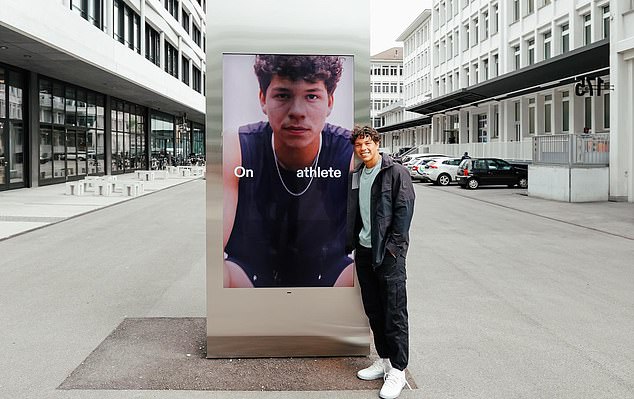
Off the court he has many sponsors and is a sought-after player on the ATP Tour
Because he developed an interest in tennis late in life, Shelton never traveled the world as a junior.
“My upbringing was very different from other tennis players,” he says. “I was home all the time. I went to a normal school, I played the American circuit of junior tournaments that were only on the weekends, so I didn’t play week-long tournaments in different countries. I never left the country until last year (for the Australian Open).
‘A lot of people think you have to travel the world and be a top junior to make it on the pro tour, but for me it was a different path. I was on a different timeline than everyone else, but I ended up in the same place.’
An upbringing outside the hotbed of junior tennis has made Shelton an outgoing and engaging companion, his toothy, megawatt smile never far away. He has also brought the gait of a high school quarterback to the court. His “dial in” celebration at last year’s U.S. Open — he pretended to hang up the phone — so excited Novak Djokovic that he imitated it after beating Shelton in the semifinals.
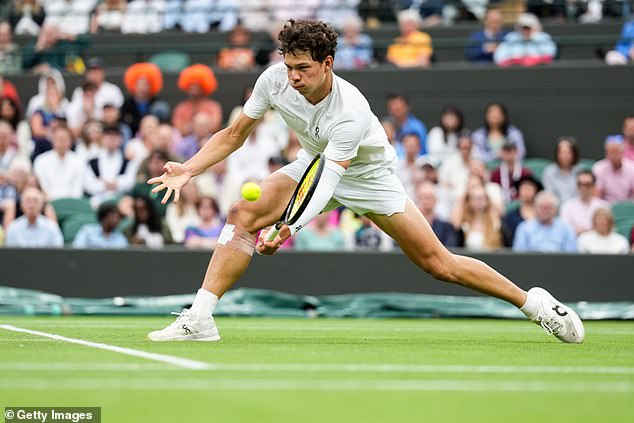
Shelton makes a return to the net during his match against Jannik Sinner at Wimbledon
That celebration brought accusations of arrogance, but Perelman is adamant: “He’s confident, but not arrogant,” he insists. “This is a special guy, one of a kind. He can walk into a room and light it up.”
With the end of the Big Three era nearing and many of today’s top players shunning rather than embracing the spotlight, Shelton is the type of character the tennis world desperately needs.
“He loves that spotlight and wants to do something special with it,” Perelman says with uncle-like pride. “He wants to get young kids involved, he wants to help the community in whatever way he can. If you ask young kids now if they know who Ben Shelton is, it’s going to be a big deal.
‘Benny and Coco Gauff, they could be the face of American tennis for the next 10 years.’
